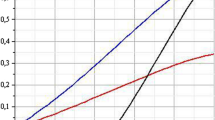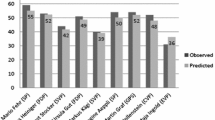Abstract
Weighted scoring rules, perhaps the most common procedures for multi-candidate, single-winner elections, are defined by score vectors, of which the Borda Count is the best known example. The concept of Borda dominance identifies candidates who cannot win under any score vector; we assess its usefulness in the context of single-winner elections. We propose several families of score vectors that can accommodate any number of candidates, asking whether any of them can improve on Borda Count. Using large-scale simulation, we compare score vectors on Condorcet efficiency, or ability to find a Condorcet winner when one exists, on resilience to ballot truncation, and on ability to maximize the Copeland score using both complete and uniformly truncated ballots. Borda performs well on criteria related to Condorcet winner and Copeland score but, depending on the preference model, may not be optimal. Convex score vectors are the most resilient to ballot truncation.




Similar content being viewed by others
Change history
26 November 2021
A Correction to this paper has been published: https://doi.org/10.1007/s00355-021-01378-z
References
Ayadi M, Ben Amor N, Lang J, Peters D (2019) Single transferable vote: Incomplete knowledge and communication issues. In: AAMAS 19: Proceedings of the 18th International Conference on autonomous agents and multiagent systems, International Foundation for Autonomous Agents and Multiagent Systems, pp 1288–1296
Ayadi M, Ben Amor N, Lang J (2020) Approximating voting rules from truncated ballots. arXiv:2002.06009, 13 February 2020
Benoit J-P (1992) Scoring reversals: a major league dilemma. Soc Choice Welf 9:89–97
Bentert M, Skowron P (2019) comparing election methods where each voter ranks only few candidates. arXiv:1901.10848, 30 January 2019
Black D (1958) Theory of committees and elections. Cambridge University Press, Cambridge
Brams SJ (1982) The AMS nominating system is vulnerable to truncation of preferences. Not AMS 29:136–138
Cervone DP, Gehrlein WV, Zwicker WS (2005) Which scoring rule maximizes Condorcet efficiency under IAC? Theory Decis 58(2):145–185
Cullinan J, Hsiao SK, Polett D (2014) A Borda count for partially ordered ballots. Soc Choice Welf 42:913–926
Dogan O, Giritligil AE (2014) Implementing the Borda outcome via truncated scoring rules: a computational study. Public Choice 159:83–98
Emerson P (2013) The original Borda count and partial voting. Soc Choice Welf 40:353–358
Filmus Y, Oren J (2014) Efficient voting via the top-\(k\) elicitation scheme: a probabilistic approach. In: EC 14: Proceedings of the Fifteenth ACM Conference on economics and computation, ACM, pp 295–312
Fishburn PC (1981) Inverted orders for monotone scoring rules. Discrete Appl Math 3:27–36
Fishburn PC (1964) Decision and value theory. Wiley, New York
Fishburn PC (1974) Paradoxes of voting. Am Polit Sci Rev 68:537–546
Fishburn PC, Gehrlein W (1978) Condorcet paradox and anonymous preference profiles. Public Choice 26:1–18
Fishburn PC, Brams SJ (1983) Paradoxes of preferential voting. Math Mag 56:207–214
Fraenkel J, Grofman B (2014) The Borda count and its real world alternatives: comparing scoring rules in Nauru and Slovenia. Aust J Polit Sci 49:186–205
Gehrlein WV (2003) Coincidence probabilities for simple majority and positional voting rules. In: Sertel MR, Koray S (eds) Advances in economic design. Springer-Verlag, Heidelberg, pp 53–63
Gehrlein WV, Fishburn PC (1978) Coincidence probabilities for simple majority and positional voting rules. Soc Sci Res 7:272–283
Gillett R (1977) Collective indecision. Behav Sci 22:383–390
Gilbaud GT (1952) Les théories de l’intérêt général et le problème logique de l’agréation. Écon Appl 5:501–584
Kalech M, Kraus S, Kaminka GA, Goldman CV (2011) Practical voting rules with partial information. Auton Agents Multi-Agent Syst 22:151–182
Kamiya H, Orlik P, Takemura A, Terao H (2006) Arrangements and ranking patterns. Ann Combin 10:219–235
Kamwa E (2021) To what extent does the model of processing sincere incomplete rankings affect the likelihood of the truncation paradox? hal-02879390v2, Université des Antilles
Kilgour DM, Grégoire J-Ch, Foley AM (2020) The prevalence and consequences of ballot truncation in ranked-choice elections. Public Choice 184(1):197–218
Lackner M (2014) Incomplete preferences in single-peaked electorates. In: AAAI-14, Proceedings of the Twenty-Eighth AAAI Conference on artificial intelligence, pp 742–748
Lepelley D (1993) On the probability of electing the Condorcet loser. Math Soc Sci 25(2):105–116
Llamazares B, Peña T (2015a) Positional voting systems generated by cumulative standings functions. Group Decis Negot 24:777–801
Llamazares B, Peña T (2015b) Scoring rules and social choice properties: some characterizations. Theory Decis 78:429–450
Marchant T (2001) The probability of ties with scoring methods: Some results. Soc Choice Welf 18:709–735
Margolis H (1977) Probability of a tie election. Public Choice 31:135–138
McIntee TJ, Saari DG (2017) Likelihood of voting outcomes with generalized IAC probabilities. Math Soc Sci 87:1–10
Merlin V, Tataru M, Valognes F (2000) On the probability that all decision rules select the same winner. J Math Econ 33:183–207
Meyers A, Orrison ME, Townsend J, Wolff S, Wu A (2014) Generalized Condorcet winners. Soc Choice Welf 43:11–27
Montes I, Rademalker M, Pérez-Fernández R, De Baets B (2020) A correspondence between voting procedures and stochastic orderings. Eur J Oper Res 285:977–987
Narodytska N, Walsh T (2014) The computational impact of partial votes on strategic voting. arXiv:1405.7714
Nurmi H, Salonen H (2008) More Borda count variations of project assessment. AUCO Czech Econ Rev 2:109–122
Oren J, Flimus Y, Boutilier C (2013) Efficient vote elicitation under candidate uncertainty. In: IJCAI-13: Proceedings of the Twenty-Third International Joint Conference on artificial intelligence, AAAI Press, pp 309–316
Pérez-Fernández R, De Baets B (2019) The superdominance relation, the positional winner, and more missing links between Borda and Condorcet. J Theoret Polit 31:46–65
Reilly B (2002) Social choice in the South Seas: electoral innovation and the Borda count in the Pacific Island countries. Int Polit Sci Rev 23:355–372
Saari DG (1984) The ultimate of chaos resulting from weighted voting systems. Adv Appl Math 5:286–308
Saari DG (1992) Millions of election outcomes from a single profile. Soc Choice Welf 9:277–306
Saari DG (1995) Basic geometry of voting. Springer, Berlin
Saari DG (1999) Explaining all three-alternative voting outcomes. J Econ Theory 87(2):313–355
Saari DG (2000) Mathematical structure of voting paradoxes. Econ Theory 15:1–53
Saari DG, McIntee TJ (2013) Connecting pairwise and positional election outcomes. Math Soc Choice 66:140–151
Stein WE, Mizzi PJ, Pfaffenberger RC (1994) A stochastic dominance analysis of ranked voting systems with scoring. Eur J Oper Res 74:78–85
Van Newenhizen J (1992) The Borda method is most likely to respect the Condorcet principle. Econ Theory 2(1):69–83
Wilcox R (2019) Can sports show the way to smarter voting?, May 15, 2019. http://www.deadspin.com/can-sports-show-the-way-to-smarter-voting-1834144248. Accessed 22 Aug 2019
Acknowledgements
The authors thank two anonymous referees for extensive and insightful comments that helped us to improve the paper. This work was supported by the Canadian Tri-Council Research Support Fund, specifically by the authors’ individual Natural Sciences and Engineering Research Council of Canada (NSERC) Discovery Grants.
Author information
Authors and Affiliations
Corresponding author
Additional information
Publisher's Note
Springer Nature remains neutral with regard to jurisdictional claims in published maps and institutional affiliations.
The original online version of this article was revised due to incorrect Tables 5 and 7. Now, they have been corrected.
Rights and permissions
About this article
Cite this article
Kilgour, D.M., Grégoire, JC. & Foley, A.M. Weighted scoring elections: is Borda best?. Soc Choice Welf 58, 365–391 (2022). https://doi.org/10.1007/s00355-021-01347-6
Received:
Accepted:
Published:
Issue Date:
DOI: https://doi.org/10.1007/s00355-021-01347-6




